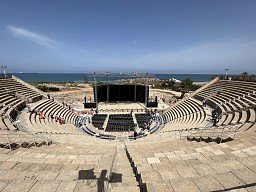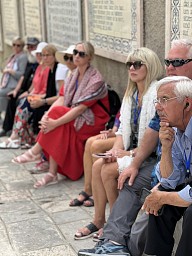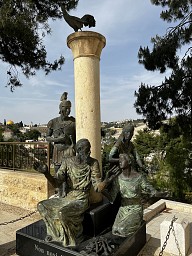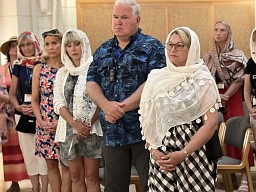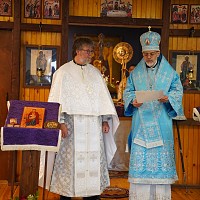Паломники УПЦ США Продовжують Подорожувати Місцями Святої Землі
The third day of the Pilgrimage to the Holy Land found the 33 Pilgrims enjoying a leisurely day in Caesarea, along the coast of the Mediterranean Sea. The first stop of the day was at an ancient aqueduct. The Judaean port of Caesarea had no reliable source of fresh water when construction on the city began around 22 BC. King Herod commissioned a raised aqueduct to deliver water from the springs from the southern side of Mount Carmel, at Shummi, 10 miles northeast of Caesarea. Since even this was not sufficient, a second aqueduct was built by the Legions of the Emperor Hadrian (2nd century AD). Hadrian’s improvement on the work of Herod can be seen on the beach portion of the high-level aqueduct, which is where the group of pilgrims clamored up the old stones to take photos and get their first view of the Mediterranean Sea just beyond the aqueduct.
Having reveled in the architectural expertise of the ancient civilization, the pilgrims traveled further until they reached the Caesarea Maritma, where the apostle Peter baptized the first recorded gentile convert to Christianity — Cornelius, a centurion in the Roman army. This site figures repeatedly in Christian history. It was the headquarters of Pontius Pilate. From here the Roman procurator set out for the Passover festival in Jerusalem, where he sentenced Jesus to death. Here the apostle Paul was imprisoned for two years and preached to the last of the Herod’s, King Agrippa II, who said that if he were to listen any longer to Paul’s persuasion, he might become a Christian. The city was the home of Philip the evangelist and his four daughters, who were prophetesses. Paul stayed with them when he returned from his missionary journeys. After Jerusalem was destroyed, Caesarea became the center of Christianity in Palestine. A Church council held here in AD 195 determined that Pascha should be celebrated on a Sunday.
Disembarking from the bus, the pilgrims were immediately admitted to a small, darkened theater where they were shown a movie on the history of the construction of the port city. Caesarea was founded by Herod the Great (the one who had all the male children 2 years and younger slaughtered in Bethlehem in his attempt to kill Christ) in 22 BC, with no expense spared. Massive breakwaters gave safe anchorage to 300 ships, a sewage system was flushed by the tide, and a vast hippodrome seated more than 20,000 people at chariot races. Later an amphitheater was built to present chariot races, gladiatorial combats, animal performances and theatrical events.
Shielding their eyes from the bright sun, the group made its way along the worn limestone passageway as they entered into a vast open area with a large stage to their right and rows of rows of stone steps to their left to seat 3,500 individuals. Below the seats is an empty area, in which they stood, which was able to be closed off and filled with water for maritime battle scenes to the joy of the onlookers. The marble stage had little nooks carved into it where would have stood statues of deities. Historically, only men were permitted to be actors. To depict women, the men would wear dresses and masks. The fact that they wore masks and therefore had varying personalities gave birth to the term hypocrite.
Further down the path the group came upon Herod’s seaside palace, where was discovered an archaeological find with an inscription mentioning the name "Pontius Pilatus"; a double aqueduct that brought water from springs at the foot of Mount Carmel; a boundary wall; and a wide moat protecting the harbor to the south and west. The harbor was the largest on the eastern Mediterranean coast. As the pilgrims leaned against the parapet, they gazed into the churning waters of the Mediterranean Sea, through which they could easily make out Herod’s ancient pool, the mosaics shimmering through the clear sparkling waters.
Leaving behind the Palace, which contained the ruins of the room in which St. Paul was detained, the pilgrims walked the length of the Hippodrome which had hosted many gladiator games. In Byzantine times the bloody games were suspended, however, the structure continued to be used for horse and chariot races. It was not difficult to imagine the neighing horses racing around the circumference of the arena.
On the far end they entered the Crusader Fortress, with its angled walls which allowed the defenders to easily see the enemy below them. Exiting through a tall, vaulted structure, the pilgrims gazed up at the Crusader church, which was never completed, due to the unstable ground below.
The bus next dropped the pilgrims off in a beautiful, wooded area – Ein Karem, which is traditionally believed to be the birthplace of St. John the Baptist, as well as the location where the pregnant Virgin Mary came to visit her elderly aunt Elizabeth, who was pregnant with St. John. Here the Virgin remained for 5 months assisting her aunt. The group made their way to the grotto containing the well, where the two pregnant women met, and then climbed the 175 steps to the church built at the top of the hill, where the summer home of Elizabeth and Zechariah was located. The climb took some time, but nobody complained as the steps were flanked by lush greenery, blooming bushes, flowers, and endless birdsong.
Reaching the top, the pilgrims walked along the wide porch surrounding the church, availing them of a picturesque view of the surrounding landscape. The Church of the Visitation designed by Antonio Barluzzi was completed in 1955. The walls inside the church were covered in frescoes depicting various historic events from the life of the Virgin Mary. After the long descent back down through the lush landscape the pilgrims were dropped off at the traditional location of the birth of St. John the Baptist.
Entering the large courtyard which lead to the church, the pilgrims noted the tiled plaques all along the walls, with the Canticle of Zechariah written in dozens of languages – including a Ukrainian plaque and an English one. “Blessed be the Lord, The God of Israel; He has come to His people and set them free. He has raised up for us a mighty Savior, Born of the house of His servant David.”
The group paused in the shade of the trees near the plaques as Archbishop Daniel read from the Gospel.
Following the crowd, the group entered the old church parts of which were built as early as the 11th century, with the lower sections dating back as far as the Byzantine period (4th Century). Slowly the pilgrims made their way to the lower chambers, where they finally walked through an arch with a Latin inscription reading “The precursor of God was born here.” Here they were able to view the spot where St. John the Baptist was believed to have been born.
Having enjoyed a traditional ancient meal of fish the day before, this day’s lunch was an unexpected surprise. In the middle of the small town of Neve Ilan, they pulled up to small eatery – the Elvis Presly Diner. The brightly colored diner is covered in more than 700 pieces of Elvis memorabilia, from photos to posters to giant statues. The jukebox is filled with Presley’s hits ranging from “Heartbreak Hotel” to “Jailhouse Rock.”
Having enjoyed the taste of Americana in a far away land, the satiated pilgrims once again boarded their bus and settled in for a lengthy drive to the highlight of this trip – the holy city of Jerusalem. As the sun dipped low in the sky, the group made one final stop before heading to the hotel for the evening. Exiting the bus they walked up a spiraling drive and came to the courtyard before the Petrus in Gallicantu church.
The Church of “Petrus in Gallicantu” (Latin for: “Peter of the Cock crow“) is a dominant structure on the sheer hillside of Mount Zion. By Christian tradition it marks the place where Jesus was imprisoned when interrogated by the high priest Caiaphas and denied by Peter (Mark 14:30). The current church, built in 1924-1931, is constructed over ancient churches and over remains of an estate of a wealthy Jew from the time of Jesus. On its roof rises a golden rooster atop a black cross — recalling Christ’s prophesy that Peter would deny him three times “before the cock crows”.
Pausing at the impressive brass doors, the group marveled at the relief depicted of Christ telling Peter that he would betray him today, before the rooster crowed thrice. With this image setting the mood, they pulled the heavy doors open and entered the darkened interior of the church. Making their way inside their eyes were immediately drawn to the huge cross-shaped window in the ceiling. Below the circular church walls are covered by large mosaics, one depicting a bound Jesus being questioned in the house of Caiaphas. The group paused to gaze through an opening, which was the peephole from the Roman guardroom so they could keep an eye on the prisoners, to the dungeon below, through which it is said Christ was lowered. Ancient crusader crosses can be seen etched into the limestone of the prison entrance.
Descending into the dungeon below, the group grew silent as they envisioned Christ being held here overnight before His crucifixion. All throughout the prison, little group of people quietly gathered in prayer and contemplation, some crying, others quietly praying, all horrified that the Lord could have been treated this way.
Exiting through the back door of the church the group found themselves looking up at the bronze statue of Peter denying Christ, as a rooster stretched out above him crowing into the sky. Stepping past the statue and wondering off to the far side, they could just make out the ancient and crumbling marble steps dating from the time of Jesus, leading down from Mount Zion to the Kidron Valley. These stone steps were certainly in use at the time of Christ. On the evening of his arrest, he probably descended them with his disciples on their way from the Last Supper to Gethsemane.
With heavy hearts the group returned to their bus and soon arrived at their hotel for the night. Before heading down for dinner, they gazed out their windows at Jerusalem, the holy city, which they would be blessed to explore in the morning.
|
| |||||||||||||
















